 Many critics and wine buffs compare the pinot noirs of Felton Road to the best of Burgundy.
Many critics and wine buffs compare the pinot noirs of Felton Road to the best of Burgundy.
To those of us who love pinot noir — that elegant, complex, fully satisfying red wine that is so great with food — the biggest tragedy is that the most famous producer of such wine, France’s Burgundy region, now prices its products well out of reach for many.
It’s been argued that run-of-the-mill Burgundy these days is pricey ($50 isn’t unusual) while not being particularly enjoyable in many cases. More reliably tasty are the grand cru, top-of-the-heap Burgundies, but I challenge you to find one for less than $100 and even at that, it can be a bit of a crapshoot. The going price for the highest-end Domaine de la Romanée-Conti of the latest vintage, 2014, is around $14,000. Per bottle. It makes you wonder who buys these things now. Back in the last century, I used to buy Domaine Dujac wines but my favorite of the bunch, Clos de la Roche, now prices out at well above $500 for the 2014.
The good news for pinot buffs is that a delicious alternative is available. Perhaps a somewhat BETTER alternative, actually, since the style retains the killer balance and subtlety of the French version along with the lovely rich fruit found in many California pinots without all the offensive alcohol.
Wine critic Stephen Tanzer wrote about a wonderful pinot noir that he praised for its “dark cherry, bitter chocolate and allspice on the perfumed nose; smells like a Dujac wine (my emphasis). Lush yet airy pinot without any undue weight. The red and darker fruit flavors are complemented by a deep smokiness and sexy brown spices. A wonderfully rich, complex pinot with a very suave, long finish.”
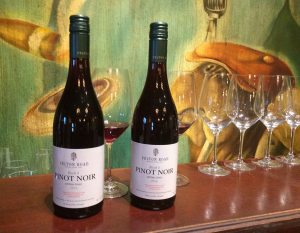 Two yummy 2016 wines tasted recently at Farallon in San Francisco.
Two yummy 2016 wines tasted recently at Farallon in San Francisco.
He was writing about the 2006 Felton Road Block 3 pinot noir from New Zealand’s beautiful, increasingly visible Central Otago region, which sold for significantly less than 10% of the price for the latest Dujac. This wine is still as haunting and fresh as the newest release, 2016, which is a testament not just to great winemaking but the advantage of the screwcap closures that typify kiwi wines.
Along with some other writers and folks from the trade, I recently attended a tasting at Farallon restaurant in San Francisco of current and earlier Felton Road wines hosted by longtime winemaker Blair Walter. All the wines — the just-released 2016 wines and an enchanting vertical of various pinot noirs — tasted were delicious and demonstrated the advantages of this cool, relatively dry (for New Zealand) region.
 Felton Road Winery, named after its street, is located in a gorgeous area with a turquoise river, craggy hills, crystalline skies and quite a few other wineries.
Felton Road Winery, named after its street, is located in a gorgeous area with a turquoise river, craggy hills, crystalline skies and quite a few other wineries.
Tanzer is by no means the first pro to compare Felton Road pinots to great Burgundies. Grand cru Vosne-Romanee is a common descriptor and at the San Francisco tasting, the common refrain was how delightfully French they were. To me, they’re a bit better than that, actually. Critic Robert Parker, who has been negative about kiwi wines (he seems to prefer alcoholic, overripe styles), had a moment of embarrassment when he placed a Felton Road pinot near the top in a blind tasting of French Burgundies.
There are many pinot noir producers in Central Otago and in New Zealand overall but Felton Road is widely considered one of perhaps the top two or three producers of this variety, if not the best. Four vineyard-designated pinots and a blend are typically available from the winery but it also makes a few terrific, lush chardonnays and remarkably low-priced riesling (alas, this variety is still a tough sell) that’s been called a dead ringer for a fine Mosel, complete with wonderful fruit and low alcohol.
 Felton Road winemaker Blair Walter
Felton Road winemaker Blair Walter
Naturally, there are a variety of factors that result in the excellence of Felton Road wines. The location with its multiple soil types is important and Walter believes the fact that the vineyards are maturing plays a big role. The first grapevines were planted there in the late ’90s, with other vineyards added in the early aughts. As is increasingly the case among exacting winemakers, Felton Road is an organic operation that uses biodynamic principles.
 Viticulturist Gareth King works with the winery’s goat herd on a hill above the winery during the winter. Cows and chickens are also part of the operation’s biodynamic program.
Viticulturist Gareth King works with the winery’s goat herd on a hill above the winery during the winter. Cows and chickens are also part of the operation’s biodynamic program.
This commitment results in a winery that’s also a mini farm, with cover crops and wildflowers planted within the vineyards, a goat herd to keep down the weeds, cows to supply manure and the cow horns used in biodynamics (perhaps the most woo-woo aspect), with more manure and eggs coming from a flock of chickens. Indeed, as part of this circle of life, a cow hide from a tasty beast that once roamed the hills is now a rug in the tasting room.
 My husband in the tasting room at Felton Road, with a cowhide harvested from the winery’s herd serving as a rug on the floor.
My husband in the tasting room at Felton Road, with a cowhide harvested from the winery’s herd serving as a rug on the floor.
Winemaker Walter uses natural yeast to ferment his outstanding grapes and much less new oak is employed than the norm in California wineries. As is typical of kiwis, organic farming isn’t just a marketing concept at the Felton Road Winery.
Sustainable practices and other kind-to-mother-earth approaches are significantly more common among New Zealand wineries than in our part of the world. For example, Felton Road uses lighter-weight bottles to lessen the carbon footprint of products that are shipped worldwide, with Walter explaining during the San Francisco tasting that this reduces the fuel required to get his wines all the way from down under to the UK than what’s involved in shipping wines to the UK from the South of France, a relative neighbor.
 One of the older vineyards near the tasting room at Felton Road right before last season’s harvest in late March-April. The rampaging birds in New Zealand cause most Central Otago wineries to net their vineyards.
One of the older vineyards near the tasting room at Felton Road right before last season’s harvest in late March-April. The rampaging birds in New Zealand cause most Central Otago wineries to net their vineyards.
The environmental consciousness wouldn’t be quite as compelling if the wines didn’t deliver as well as they do. But as one of the premier producers in New Zealand, Felton Road doesn’t make cheap wines, as they shouldn’t given the care that goes into their bottles. The least expensive pinot noir is the Bannockburn, a blend of various vineyards. The 2016, just released, is $40 and lovely it is. The 2016 Calvert and Cornish Point are $55 and a bit more complex (although the Bannockburn is no slouch), while the bigger, richer 2016 Block 3 and Block 5 wines are $70. (These prices come from the K&L website.)
 Gareth King giving us a tour of the vineyard last March.
Gareth King giving us a tour of the vineyard last March.
These prices might seem high to those not savvy about stellar pinot noir today. Good luck finding a Burgundy from any winery that is as delicious as these for similar prices — or anything close. The most esteemed California pinots cracked the $100 mark awhile ago. Marcassin, Peter Michael, Kistler and the other stars are virtually unavailable other than on the secondary market, routinely costing significantly more than the most expensive Felton Road, even at release price. I’m happy to say I’ve frequently consumed these California cult pinots over the years and I’d put the Felton Road wines against them any day.
Now here’s the not-so-great news. Felton Road wines (don’t overlook the divine chardonnays or the sublime riesling, which is a bargain) aren’t particularly abundant in the Bay Area. The winery makes just 12,000 cases and hasn’t been increasing production and won’t be in the future either, says Walter. They export 75% of their bottles but a measly 7% makes it to the United States. Felton Road used to sell its wine in several locations across the country but has now whittled this down to just California, New York and Washington, D.C.
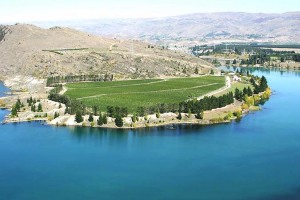 The picturesque Cornish Point vineyard, which is on a little peninsula at the point where the Kawarau and Clutha rivers meet and flow into Lake Dunstan.
The picturesque Cornish Point vineyard, which is on a little peninsula at the point where the Kawarau and Clutha rivers meet and flow into Lake Dunstan.
Fortunately, we in the Bay Area have a great source at K&L Wine Merchants, with local stores in San Francisco and Redwood City. The down-under wine buyer, Ryan Woodhouse, has excellent relationships with kiwi producers and seems to get a reasonable supply. But “reasonable” doesn’t mean abundant. In addition, K&L’s prices are typically below retail, which helps.
Once a true pinot noir lover tries Felton Road wines, it’s difficult not to covet them unless astringent Burgundies or late-harvest-style California wines are your preference (chacun à son goût). So the supply gets snapped up at K&L but if you make your move right after the new release (which is now), the wines can be found and even some from earlier vintages, which is a good strategy since the wines age like a dream and last years.
 Felton Road Winery in fall, which is our spring in the Northern Hemisphere.
Felton Road Winery in fall, which is our spring in the Northern Hemisphere.
There’s no doubt that the wines will get even better over the coming years, if that’s possible. Viticulturist Gareth King — part of a dynamic duo with winemaker Walter — made a statement last March that could be apocryphal:
“We’re just starting to understand how to grow grapes here. New Zealand wine is in its infancy. We’re not even teenagers yet.”
The bigger story is how good and affordable New Zealand wines are overall these days. And this resplendent, friendly country is a spectacular place to do wine touring. To find out more and learn where to drink and buy these wines in the Bay Area, go to my post on KQED’s Bay Area Bites food and wine report.
To get you in the mood, here are photos of a few of the unimaginably beautiful wine countries in this Tolkien landscape. These photos move from the south to the north but by no means include all New Zealand’s 10 main wine regions comprising about 700 wineries, making everything from big, bold cabernets to lovely, light white wines.
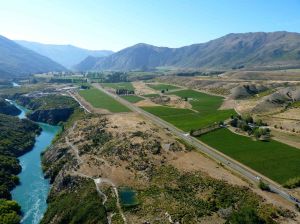 The Gibbston Valley lies along the technicolor Kawarau River near Queenstown and is in the Central Otago region on the South Island. Besides wonderful wine, the area is great for hiking, biking and bungee jumping.
The Gibbston Valley lies along the technicolor Kawarau River near Queenstown and is in the Central Otago region on the South Island. Besides wonderful wine, the area is great for hiking, biking and bungee jumping.
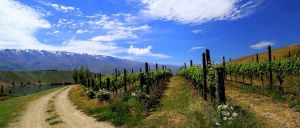 Another part of Central Otago, which includes several districts on the South Island.
Another part of Central Otago, which includes several districts on the South Island.
 Often called, “the most beautiful winery in the world,” Rippon is in Central Otago next to Lake Wanaka, with one of New Zealand’s many glaciers sitting in the distance.
Often called, “the most beautiful winery in the world,” Rippon is in Central Otago next to Lake Wanaka, with one of New Zealand’s many glaciers sitting in the distance.
 The gorgeous Waipara Valley is north of Christchurch on the South Island and is an up-and-coming region making various wines but notable for pinot noir and chardonnay.
The gorgeous Waipara Valley is north of Christchurch on the South Island and is an up-and-coming region making various wines but notable for pinot noir and chardonnay.
 The Marlborough region at the top of the South Island is by far the biggest in New Zealand and is the main home to its massive planting of sauvignon blanc, which is what many people think of when they consider kiwi wines.
The Marlborough region at the top of the South Island is by far the biggest in New Zealand and is the main home to its massive planting of sauvignon blanc, which is what many people think of when they consider kiwi wines.
 Incredible clouds and brilliant blue skies are common in the Martinborough region, home to superstar pinot producer Ata Rangi, whose vineyards utilize cuttings that came from France’s Romanée-Conti. This region is in the south of the North Island and is an hour’s drive away from Wellington.
Incredible clouds and brilliant blue skies are common in the Martinborough region, home to superstar pinot producer Ata Rangi, whose vineyards utilize cuttings that came from France’s Romanée-Conti. This region is in the south of the North Island and is an hour’s drive away from Wellington.
 For big red wine lovers, Hawkes Bay on the east side of the North Island is home to some stellar producers who make luscious Bordeaux-style wines and excellent syrahs. As is common in New Zealand, the ocean lines one side of this region.
For big red wine lovers, Hawkes Bay on the east side of the North Island is home to some stellar producers who make luscious Bordeaux-style wines and excellent syrahs. As is common in New Zealand, the ocean lines one side of this region.
 Gimblett Gravels is a sub-district in Hawkes Bay and displays the rugged low hills so common across both islands. Fall is one of four beautiful seasons in New Zealand.
Gimblett Gravels is a sub-district in Hawkes Bay and displays the rugged low hills so common across both islands. Fall is one of four beautiful seasons in New Zealand.
 A ferry ride away from New Zealand’s biggest city, Auckland, on the North Island is dazzling Waiheke Island, known for bewitching scenery, mansions and lots of serious wineries making big red wine.
A ferry ride away from New Zealand’s biggest city, Auckland, on the North Island is dazzling Waiheke Island, known for bewitching scenery, mansions and lots of serious wineries making big red wine.
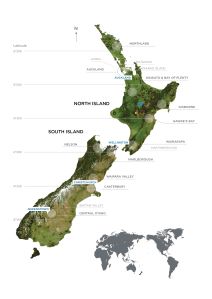 New Zealand’s wine regions are spread all across this ravishing country.
New Zealand’s wine regions are spread all across this ravishing country.
